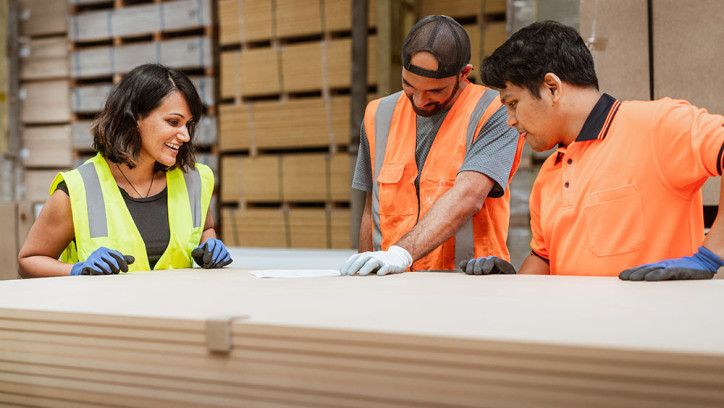About overseas products and standards
Last updated: 30 May 2024

The overseas products and standards initiatives remove barriers to overseas products and standards being used in New Zealand.
Aotearoa/New Zealand imports about 90 per cent of all building products (or components) sold in the country.
It can be time consuming for building consent authorities to review and make a decision on new or innovative products that they have not seen before. This adds cost to suppliers and designers who may need to provide more information each time they apply for a building consent for the same product.
The Commerce Commission's market study into residential building supplies found that competition for the supply and purchase of key building supplies is not working as well as it could.
It is too slow and costly to get overseas building products accepted for general use. Typically designers choose products that they know will be easily accepted even though the non-prescriptive Building Code allows for any product to be used as long as it is shown to comply with the Building Code.
To enhance competition in the market, the Commerce Commission recommended that the building regulatory system needed to create clear compliance pathways for more key building supplies and make it easier for designers to show that the products they have chosen comply with the Building Code.
How this will be achieved
Changes to the Building Act 2004 are being progressed and are intended to deliver the greatest benefit for Kiwis through improved competition and lowered costs of building, ensuring our homes and buildings are safe and durable. This will be achieved by:
Recognising certain overseas standard organisations
Using a set of criteria, the Government will recognise overseas standards organisations and standards certification schemes. This will make it easier for any building product that has met an appropriate standard from a recognised standards organisation to be specified in a building design.
The change will remove the need for designers, builders, building owners and building consent authorities to verify the adequacy of a standard or the robustness of a product certification scheme, and allow them to rely on what has been recognised by the Government.
Building consent authorities typically must rely on information on equivalent standards and the performance of products. The change will ensure that building consent authorities are protected where specified standards from overseas standards organisations and standards certification schemes are used.
Example of possible overseas standards organisations
Overseas standards organisations that could be recognised as providing standards equal to, or better than what we already have in Aotearoa/New Zealand include Standards Australia, British Standards Institute (BSI), International Organisation for Standardisation (ISO), American Society for Testing and Materials (ASTM).
Standards certification schemes that could be recognised include Underwriter’s Lab (UL Mark), International Code Council Evaluation Services (ICC-ES mark), Intertek certified building products, or similar.
Streamlining the citing of international standards
The Government is amending the Building Act to enable a new regulatory instrument (called the building product specification) to be published. This will contain all the building product specifications and standards that can be used with the acceptable solutions and verification methods to demonstrate compliance with the Building Code.
As long as a product (no matter where it is from) complies with an equal standard for its specific purpose, the building can comply with the acceptable solutions and verification methods and the building must be accepted by Building Consent Authorities.
Implementation will involve moving product manufacturing and testing standards from the acceptable solutions and verification methods that are published under the Building Act to the building product specification.
MBIE’s initial thinking in implementing building product specifications is to focus on identifying equal standards, where the main costs of construction are concentrated (eg standards relating to products such as internal linings, external cladding, windows, plumbing products and insulation).
Example of how the building product specification will work with the Acceptable Solution C/AS2 for Protection from Fire
The building product specification would be used with the existing acceptable solutions and verification methods for compliance with the Building Code and would not replace them.
As an example, the existing Acceptable Solution C/AS2 for Protection from Fire contains an appendix list of fire testing standards and specifications for products.
In the future, these fire testing standards and specifications would be published in the building product specification, alongside other suitable overseas standards that provide an equivalent or better level of performance. C/AS2 would reference the building product specifications.
When new standards are identified that are suitable for use, the building product specification will be amended to incorporate the new standards.
Mandating the acceptance of products certified overseas
Currently, CodeMark is the product certification scheme in Aotearoa/New Zealand that shows a building product or method meets the requirements of the Building Code.
To increase flexibility and enable effective and proactive implementation of existing provisions, the Building Act will be amended to:
- enable the Chief Executive of MBIE to be able to recognise entire schemes, or classes or groups of products.
- remove existing requirements for certification and add a regulation-making power to set criteria for the recognition of certified products.
- require building consent authorities to accept recognised overseas products as establishing compliance with the Building Code.
There will also be decision making-criteria in regulations to guide the Chief Executive’s decisions.
Example of possible specified certification schemes
The Chief Executive may specify that products certified under the Australian WaterMark certification scheme are suitable for Aotearoa/New Zealand, which could open up the Aotearoa/New Zealand market to more plumbing products approved for use in Australia. There are currently over 200,000 plumbing products in the WaterMark register.
Additional information
Subscribe
Subscribe to regular Building Performance email updates.
Feedback
If you have any questions or enquiries, please email building@mbie.govt.nz